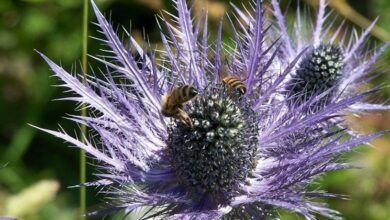Bastard Chamomile (Helichrysum stoechas)

In the Mediterranean region we can find a large number of wild plants that will give us many joys if we grow them in gardens and/ or in pots. One of them is what is known as Helichrysum stoechas, which due to its characteristics is called bastard chamomile.
It does not grow much, and yet it produces a large number of flowers every year. And the best thing is that, being original places where it rains rather little, it is quite resistant to drought.
Origin and characteristics

Image – Wikimedia/ Ghislain118
Our protagonist is a herbaceous native to the Mediterranean region, where it grows in dry, arid and stony soils, often near the sea. Its scientific name is Helichrysum stoechas, although it is known as bastard chamomile, yellow amaranth, ordinary chamomile, chamomile, immortelle, or yellow immortelle.
It reaches a height of up to 70 centimeters, and produces erect stems from which thin, linear, tomentose and gray-green leaves sprout. When rubbed, they give off an intense aroma. The flowers are grouped in capitular inflorescences, they are hermaphroditic in the center and female in the periphery, yellow in color. The seeds are about 3mm. It blooms from spring to mid-summer.
There are two accepted subspecies:
- Helichrysum stoechas subsp barrelieri
- Helichrysum stoechas subsp stoechas
What are their cares?

Image – Flickr/ jacinta lluch valero
If you would like to have a copy, we recommend that you take care of it as follows:
Location
Bastard chamomile is a plant that must be outdoors, in an area where it gets direct sunlight, if possible, throughout the day. In this way, you can have good growth and development.
Earth
- Pot: it is very important that the substrate or mixture of substrates facilitate drainage. For this reason, I advise mixing black peat with mulch and perlite in equal parts.
- Garden: grows in clay soils.
Irrigation
It must be controlled, since it does not resist flooding; What’s more, it is enough that we go through the water once or twice for its roots to rot. To avoid this, and knowing that it tolerates drought, it is important that you check the humidity of the soil before watering so that in this way your plant always has the right amount of water.
With a digital moisture meter or with a thin wooden stick it will be easy to find out what state the soil or substrate is in. Anyway, if you have doubts, wait a couple more days before adding water again.
And by the way, do not spray or wet its leaves or flowers, since otherwise you could lose them.
Subscriber

Guano powder.
From the beginning of spring to the end of summer, it must be paid with organic fertilizers, not only because it has medicinal properties that we will now see, but also because it is a way of taking care of the environment. There is a great variety of them: guano, compost, manure, etc., there are even others that are usually at home, like the ones we tell you in this other article.
Multiplication
The Helichrysum stoechas is multiplied by seeds in spring, following this step by step:
- The first thing you have to do is fill a seedling tray (you can get it here ) with universal growing medium.
- Then, water conscientiously.
- Then, place a maximum of two seeds in each socket, and cover them with a very thin layer of substrate.
- Then spray the surface of the substrate with water.
- Finally, place the seedbed outside, in full sun.
In this way, the first seeds will germinate very soon, in 1 week.
Pruning
For a compact, rounded shape, trim off overgrown stems in late winter. Any scissors will do for you, be it specific for pruning ( here you have all the information about it) or even kitchen ones.
Of course, disinfect them before and after using them with water and a few drops of dishwasher; this way infections are prevented .
Planting or transplanting time
In spring, when the risk of frost has passed. If you are going to have it in a pot, it will be enough for you to transplant it every time it grows roots through the drainage holes, something that will only take a few years. When it has reached adult size, you can leave it there.
Plagues and diseases
It is very hardy, but can be affected by fungus if overwatered. Avoid it.
Rusticity
It resists frosts down to -7ºC.
What uses does it have?
Ornamental
It is a very decorative plant, ideal to have in a garden or in a pot. In addition, once cut and dried it is used in the composition of floral details.
Bastard chamomile properties
The flowers are medicinal. In infusion, they are known to be febrifuge and pectoral.

Image – Flickr/ José María Escolano
And with this we end with the Helichrysum stoechas file . What do you think? As you can read, it is relatively easy to care for, so it is very interesting for beginners and not so beginners who want a beautiful and medicinal plant.




